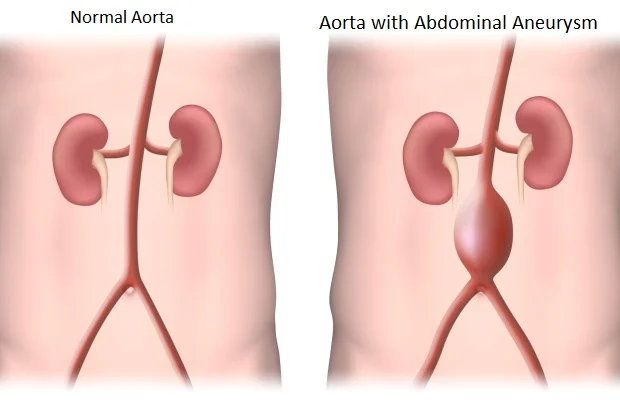Abdominal aortic aneurysm (AAA) occurs when the lower part of the aorta, the main blood vessel that supplies blood to the body, becomes enlarged or bulges outward. This condition is often asymptomatic but can lead to serious complications if left untreated.
Overview:
- Location: Abdominal aortic aneurysms occur in the section of the aorta that passes through the abdomen, typically below the kidneys.
- Size: They can vary in size, but those larger than 5.5 centimeters (about 2.2 inches) are considered at high risk for rupture.
- Risk Factors: Common risk factors include advanced age, male gender, smoking, high blood pressure, and a family history of AAA.
Symptoms:
- Often Asymptomatic: Many AAAs do not cause symptoms and are discovered incidentally during routine medical exams or imaging studies.
- Symptomatic Cases: Symptoms may include abdominal or back pain, a pulsating sensation in the abdomen, and in severe cases, signs of shock or collapse due to rupture.
Causes:
- Atherosclerosis: The most common cause of AAAs is the gradual buildup of fatty deposits (plaques) in the arteries (atherosclerosis), which weakens the arterial wall.
- Other Factors: In rare cases, genetic factors, infections, trauma, or inflammatory diseases can contribute to the development of AAA.
Prevention:
- Healthy Lifestyle: Quitting smoking, maintaining a healthy weight, managing blood pressure and cholesterol levels, and exercising regularly can reduce the risk of developing an AAA.
- Regular Screening: Screening for AAA is recommended for individuals aged 65 to 75 years who have ever smoked, as well as for those with a family history of AAA.
Treatment:
- Monitoring: Small AAAs may be monitored regularly with imaging tests to assess their growth.
- Medication: Medications to control blood pressure and cholesterol levels may be prescribed to slow the progression of AAA.
- Surgery: Surgical repair is often recommended for larger AAAs to prevent rupture. This can involve traditional open surgery or less invasive endovascular repair using stent grafts.
Complications:
- Rupture: The most serious complication of AAA is rupture, which can lead to life-threatening internal bleeding.
- Aortic Dissection: In
































